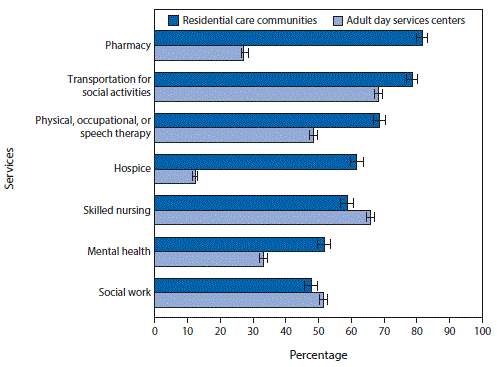QuickStats: Percentages* of Residential Care Communities and Adult Day Services Centers That Provided† Selected Services — United States, 2014
Weekly / September 9, 2016 / 65(35);945

* Differences between residential care communities (e.g., assisted living) and adult day services centers are statistically significant at p<0.05; 95% confidence intervals are shown.
† Provided by paid employees, arranged for and paid by outside providers, or arranged for or referred to outside providers that are paid by others.
In 2014, a greater percentage of residential care communities than adult day service centers provided five of seven selected services. The majority of residential care communities provided pharmacy services (82%); followed by transportation for social activities (79%); physical, occupational, or speech therapy (69%); hospice (62%); skilled nursing (59%); and mental health services (52%). Fewer than half provided social work services (48%). The majority of adult day services centers provided transportation for social activities (69%); skilled nursing (66%); and social work (52%). %). Fewer than half provided physical, occupational, or speech therapy (49%). One third or less provided mental health (33%), pharmacy (27%), and hospice services (12%).
Source: Harris-Kojetin L, Sengupta M, Park-Lee E, et al. Long-term care providers and services users in the United States: data from the National Study of Long-Term Care Providers, 2013–2014. Vital Health Stat 3(38). 2016. http://www.cdc.gov/nchs/data/series/sr_03/sr03_038.pdf.
Reported by: Jessica Penn Lendon, PhD, jlendon@cdc.gov, 301-458-4714; Vincent Rome, MPH.
Suggested citation for this article: QuickStats: Percentages of Residential Care Communities and Adult Day Services Centers That Provided Selected Services — United States, 2014. MMWR Morb Mortal Wkly Rep 2016;65:945. DOI: http://dx.doi.org/10.15585/mmwr.mm6535a6.
Use of trade names and commercial sources is for identification only and does not imply endorsement by the U.S. Department of
Health and Human Services.
References to non-CDC sites on the Internet are
provided as a service to MMWR readers and do not constitute or imply
endorsement of these organizations or their programs by CDC or the U.S.
Department of Health and Human Services. CDC is not responsible for the content
of pages found at these sites. URL addresses listed in MMWR were current as of
the date of publication.
All HTML versions of MMWR articles are generated from final proofs through an automated process. This conversion might result in character translation or format errors in the HTML version. Users are referred to the electronic PDF version (https://www.cdc.gov/mmwr) and/or the original MMWR paper copy for printable versions of official text, figures, and tables.
Questions or messages regarding errors in formatting should be addressed to mmwrq@cdc.gov.
- Page last reviewed: August 17, 2017
- Page last updated: August 17, 2017
- Content source:


 ShareCompartir
ShareCompartir